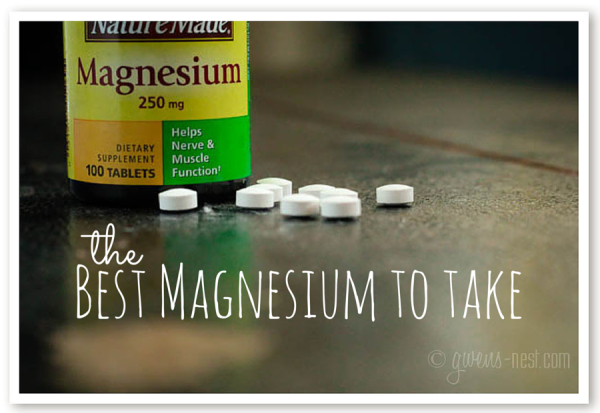 “What’s the best magnesium to take?” is a common question that I see here in comments, and on the Herbal Chick Chat group on Facebook. I’ve talked a LOT about the importance of magnesium here on the Nest, and even offered some really easy at home recipes for supplements and a DIY mag alkaline water for daily hydration, but it’s high time we talk types of magnesium. So today, we will explore and demystify magnesium supplements. Let’s go!
“What’s the best magnesium to take?” is a common question that I see here in comments, and on the Herbal Chick Chat group on Facebook. I’ve talked a LOT about the importance of magnesium here on the Nest, and even offered some really easy at home recipes for supplements and a DIY mag alkaline water for daily hydration, but it’s high time we talk types of magnesium. So today, we will explore and demystify magnesium supplements. Let’s go!
Magnesium Supplements: Many Forms
So you may have noticed that there are a LOT of different magnesium products on the shelf. And if you turn the bottles over, you’ll discover than there are dozens and dozens of different magnesium compounds in the supplements. What’s up with all these forms?
Magnesium is that it’s a “needy” mineral that is always bonded to another element in nature. There are many forms or elements that magnesium bonds to, called lignans, and they can be organic or inorganic. Here’s just a partial list of the many magnesium compounds out there:
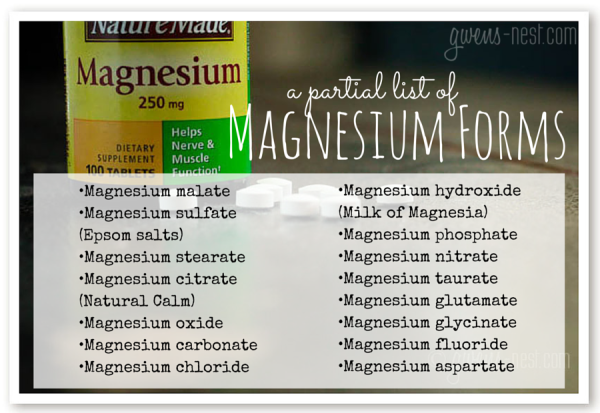
Aaarrrgghhhh! Too much, right?
And on top of that, magnesium can be sold in many different forms, from powders to pills to lotions and crystals.
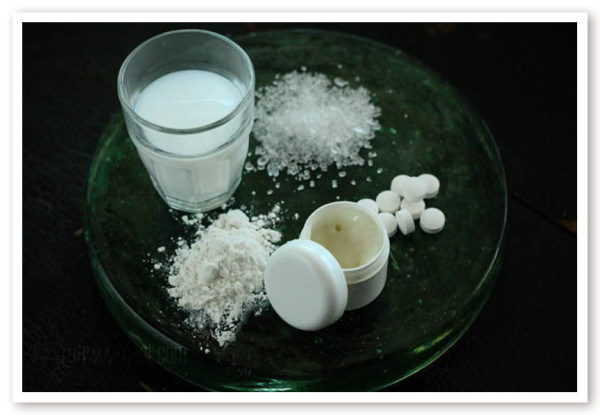
But don’t let all of this deter you…there will not be a pop quiz and you won’t have to wade through each and every product out there. I’ll break this down very easily so you’ll know exactly which supplements you want. I’ll help you sort it all out.
The Best Magnesium to Take
The first question you need to ask yourself in choosing a magnesium supplement is this: why are you taking magnesium?
There are two main uses for magnesium supplements:
- constipation/digestion
- for addressing deficiency symptoms.
Here on the Nest, I’ve mostly looked at the need for magnesium when dealing with a deficiency, but the use of magnesium as a bowel aid is a valid use. So if you’re looking for a safe, non-stimulant, non-habit forming method to soften stools and to ward off constipation, there are several forms of magnesium to consider.
The second question to cover is what form is going to be best suited to my body and needs? I’ll cover this part in each section below.
Magnesium for Constipation
Here’s why I showed you the big list of magnesium compounds: the trick to choosing a form is to know which forms are easily broken by the body. The body cannot break the strong bonds on many of the forms, and the magnesium passes through the digestive tract or right past the cells without being absorbed. These forms are often sold as effective laxatives, however some of the poorly absorbed forms are marketed as if they are good for addressing deficiency. You get two main choices for constipation: pills or liquids, and it’s just basically a preference issue.
These are the forms that I’d consider for addressing constipation:
Pills: Magnesium Oxide or Citrate
One of the most common forms of magnesium sold in grocery stores and pharmacies are magnesium oxide and magnesium citrate. Both are cheap and widely available. Though they may tout benefits of magnesium like “nerve and muscle health” on the package, they are not truly going to give you much in the way of internal absorption. Both have very high stability constants, meaning that the bonds between the components are strong and not easily ionized or broken down.1 You really are only absorbing a tiny amount of the total magnesium that you take with these pills.
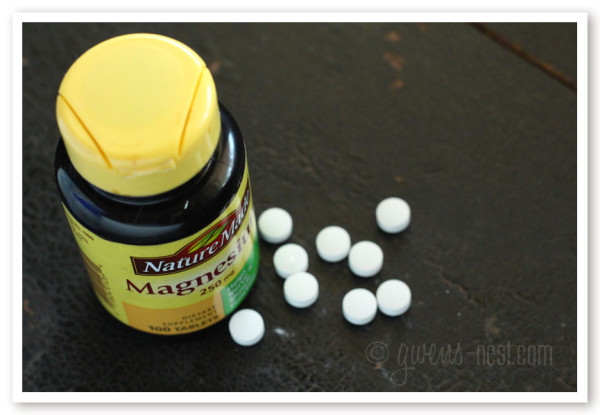
With magnesium oxide, you get about 4% of the elemental magnesium to your tissues because it’s not very bio-available. Part of the process of breaking down magnesium oxide happens in the stomach acid, so if you use acid blockers, have low stomach acid (which is fairly common), or have had any sort of stomach surgery, your ability to break down and use magnesium oxide is even further inhibited. Since most of the magnesium stays bound and isn’t absorbed, I consider magnesium oxide and magnesium citrate to be good choices for addressing constipation.
The authors of Trim Healthy Mama suggest taking two to four 250 milligram tablets of magnesium oxide each night to keep things moving. From each of those tablets, you may be absorbing somewhere around 12-24 grams of elemental magnesium out of the 500-1000 grams in the tablets. Not highly impressive, but they do a nice job of relieving constipation.
Drinks: Hydroxide, Citrate, or Sulfate
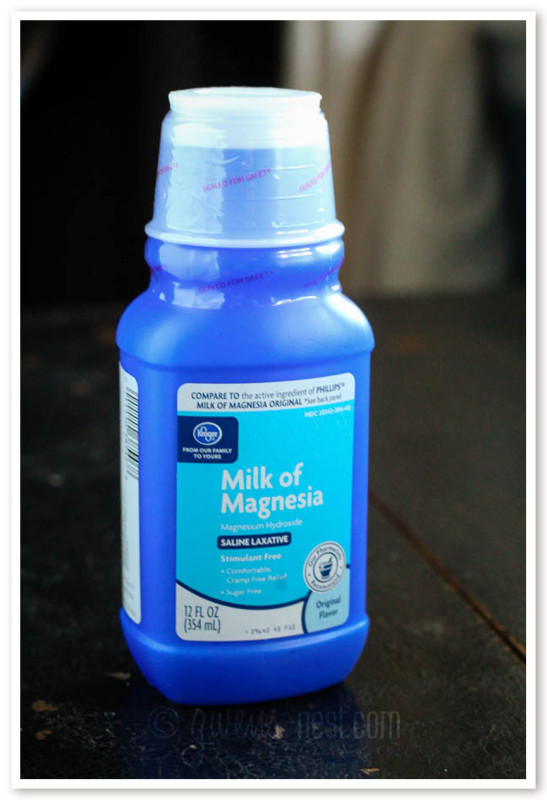 If you’re not a pills person, you may choose to use any of the following preparations as a drink to address constipation. These aren’t tasty, but they get the job done gently and without habit forming stimulants. Take them according to the package recommendations, paying careful attention to dosage amounts.
If you’re not a pills person, you may choose to use any of the following preparations as a drink to address constipation. These aren’t tasty, but they get the job done gently and without habit forming stimulants. Take them according to the package recommendations, paying careful attention to dosage amounts.
- Milk of Magnesia (Magnesium Hydroxide) A thick liquid of magnesium hydroxide mixed with water- check the inactive ingredients. Some brands add other ingredients or flavorings. MOM is also used for heartburn, as it neutralizes stomach acid. It does stimulate bowel contractions by drawing water into the bowels by osmosis, which softens stools.2
- Magnesium Citrate preparation: this is a clear liquid laxative sold in pharmacies in little glass bottles. But you’ll also see this form pop up later in a slightly different formulation for magnesium deficiency.
- Epsom Salts (Magnesium Sulfate)- this product is sold in bags, and offers instructions on mixing them into water to create a drink. Use according to package. I’ve only used this one as a bath product for absorption. This product is very versatile and has a permanent place in my medicine cabinet.
Shopping Guide for the best Magnesium to take for Constipation
(Amazon affiliate links)
- Magnesium Oxide tablets or Magnesium Citrate tablets: find these at any local drugstore or pharmacy for super cheap.
- Magnesium Citrate liquid: The prepared flavored drinks are around $2 or so per bottle at a pharmacy. I recommend dosing in 2 ounce increments every hour until you get relief. (I linked it so you can see the photo on Amazon, but I would buy this locally.)
- Milk of Magnesia- unflavored (pictured above), or Epsom salts are cheap staples in any pharmacy or grocery store.
Magnesium for Deficiency
When dealing with a deficiency of magnesium, you want a form that is easily broken down, drawn into the bloodstream, and absorbed into the cells and tissues to be used. There is a lot of confusing information out there including studies that are operating off of erroneous assumptions on how magnesium works in the body.
Interpreting Magnesium Studies
To assess how absorbable a magnesium form is, you want to look at tissue concentrations and not blood concentration or urinary or bowel output. The most accurate way to assess tissue levels is a non-invasive test like this one that your doctor can order through EXA that evaluates cells found under the tongue. But unfortunately there are very few studies that utilize tissue concentration to assess magnesium absorption.
Most studies with magnesium draw incorrect conclusions from assessing urinary output, assuming that raising blood levels is sufficient to address deficiency. It’s actually almost the opposite. You do want to see an initial raise in blood levels, but you don’t want to see all of that quickly excreted via the kidneys, since that indicates that the tissues are not able to utilize and absorb the magnesium. Or it could also possibly indicate that the person was not deficient to start with…which is why tissue assessments before and after magnesium loading tests are so valuable in interpreting results.
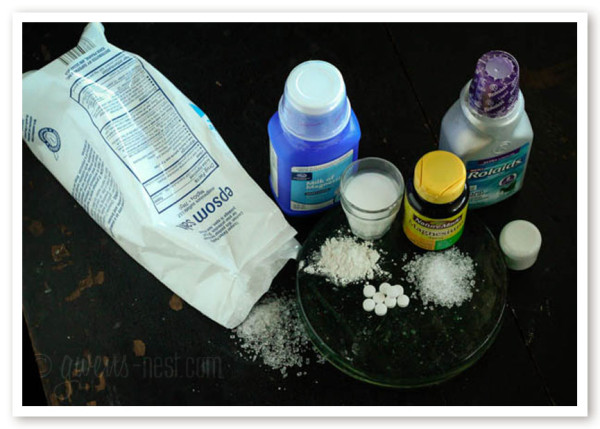 In broad term, for addressing magnesium deficiency, you really want an inorganic form so that the body can break the bonds, absorb it into the bloodstream, and draw it into the cells. But before we dive into the forms, there is another teensy little detail that we need to talk about:
In broad term, for addressing magnesium deficiency, you really want an inorganic form so that the body can break the bonds, absorb it into the bloodstream, and draw it into the cells. But before we dive into the forms, there is another teensy little detail that we need to talk about:
Magnesium Absorption: Personal Health Roadblocks
Before I give you the list of the best magnesium to take for addressing magnesium deficiency, we need to talk about something personal. Your personal health, including the health of your gut biome, the lining of your intestines and the specific gut flora that help to break down your foods is going to determine how well you tolerate supplementing with oral magnesium. If you have issues with gut inflammation, please repeat after me three times:
go low and slow
go low and slow
go low and slow
If you have loose bowels or negative reactions to any of the forms of magnesium below, then take heed. Magnesium can jump start more than 700-800 enzymatic reactions, and that can sort of send the body for a loop. That’s why those who have clear deficiency symptoms and need it the most may have negative reactions or loose bowel symptoms if you start too quickly (especially to the oral preparations).
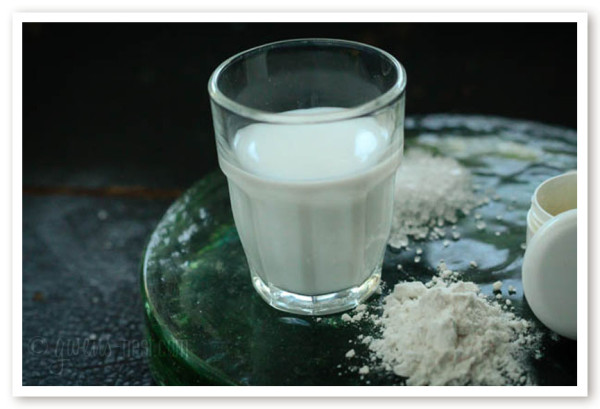
If you’d like to read more, Dr. Carolyn Dean addresses some of the underlying factors for magnesium reactions in this post (she also sells her own blends). She suggests that those with sensitivity to magnesium should start with a liquid and instead of doing full doses, do drops instead, building up every 10 days to allow your body to adjust. Remember, low and slow, and if you run into a roadblock, consider working with your doctor or holistic practitioner to address gut health and re-assess your dosage, your supplement choice, or try a topical application instead of oral. There are so many options to choose from.
A SERIOUS CAUTION: if you’ve got kidney disease, heart disease, or a history of either OR if you are taking medications, please consult with your doctor prior to using any forms of magnesium. Seriously.
Let’s jump in and take a look at the best forms of magnesium for deficiency.
Oral Forms of Magnesium for Deficiency
Pills or Capsules: Magnesium Glycinate (or Magnesium Glycine) is a capsule or pill form that I have seen mixed reviews. I’ve seen it recommended by “the experts”, but the chemistry of it doesn’t make sense to me. The stability constant (the measurement of how easily the elements disassociate or ionize) usually indicates how easily the body can break apart the compounds, and Mag glycinate has a pretty high stability constant (3.45, with anything over a 1 being difficult to absorb)4, indicating that it’s not very easy for the body to break it down. So just a plain combination of mag glycine would rate into the poorly absorbed category that would more than likely be most useful for constipation.
But what about “chelated” magnesium glycinate? I’m skeptical in general about that making much of a difference. However, this article speaks specifically to a patented form of chelated mag glycine that’s been developed by the Albion company that’s supposed to be small enough to be able to pass through the gut wall and the cell wall as a useable form of magnesium. It’s fairly affordable, and is supposed to show good results. So this one goes on my recommended list. (Amazon affiliate link)
Other recommended pill options would be
- magnesium chloride: this is a good choice for people with low stomach acid, since the chloride bonds with hydrogen in the stomach to create hydrochloric acid- a powerful digestive enzyme. Chloride is a key electrolyte and is the main negatively charged ion that plays back and forth with potassium and sodium to conduct electrical impulses within the body.3 Magnesium chloride also has a stability constant of 0, meaning that it’s very easy for the molecules to separate and for the mag to become bio-available.4
- magnesium lactate and magnesium taurate are also generally well absorbed forms to consider.
Liquid Preparations for Oral Magnesium Supplementation
The following are great options for supplementing with magnesium. With liquids, it’s very simple to adjust dosing to suit your body. Both of these options in *tablet* form are not good choices for addressing deficiency, but when they are reacted in liquid to create an ionic form, they are more readily absorbed. (Similar absorption rates to foods high in magnesium…stay tuned for that next post.)
- Magnesium Citrate, aka Natural Calm (Amazon affiliate link): Powdered magnesium citrate added to warm water is supposed to create a highly bio-available form. You can get other brands, like NOW’s basic powder, but the Natural Calm comes in some yummy flavors (orange is my favorite) and is a quick and easy way to get your magnesium in.

- Magnesium Carbonate: this is my homemade Magnesium Supplement recipe…it’s super easy and I’ve had great results using it for deficiency. I’m also now using a similar process to create my own Alkaline Water concentrate that I feel good about putting in my family’s drinking water at very low steady doses.
Topical Forms of Magnesium for Deficiency
Magnesium Chloride
There are a lot of recipes out there for making magnesium oil with magnesium chloride (Amazon affiliate link), with pretty consistent recommendations for a specific brand of flakes from a popular book on magnesium. I bought the magnesium chloride flakes and used those in my first batch. I had pretty good results, but did experience the stinging sensation when using the spray. Some people feel that this may be due to the chloride ions causing sensitivity or possibly reacting to create an irritating compound in the spray.
There are multiple products on the market to take advantage of the easily absorbed form of magnesium, including lotions, sprays (aka “oil”), bath flakes, and gels. I offer an easy DIY magnesium oil recipe here.
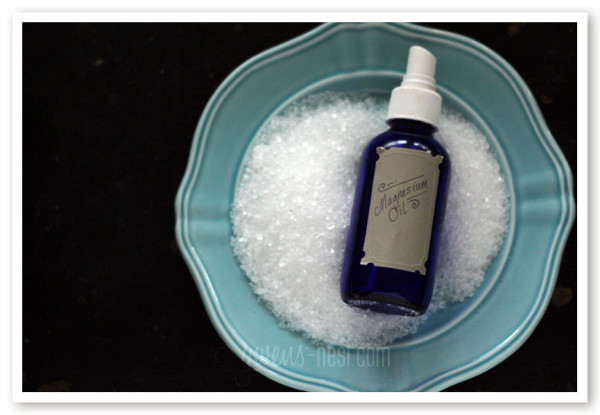
One of the benefits of the magnesium chloride flakes is that they LOVE water, so they’re very easy to dissolve. But one of the drawbacks of the magnesium chloride flakes is that they LOVE water, and absorb it from the air. This is my bag of mag chloride flakes after sitting in my cabinet (sealed!) for several months.

mmm…soupy.
So before you buy a large bag to save some money on magnesium chloride flakes, consider that it can turn into a liquid if you store it for extended periods of time. I guess it saves you a step in making your bath or oil?
Epsom Salts: Magnesium Sulfate
There is another (cheaper) topical option that boasts no stinging: magnesium sulfate. Based on this article, and on all of the positive input I’ve heard from friends who take epsom salt baths regularly, I do believe that you can get good results using the less expensive and widely available epsom salts (magnesium sulfate) both in sprays and in baths.
Though there is not a lot of understanding on how this works, bathing in magnesium sulfate seems to allow it to pass into the bloodstream. Research done by the University of Birmingham there is an increased blood level of magnesium and sulfate after bathing in epsom salts. Over the course of the weekly bathing, the baseline magnesium blood levels of all but 2 of the participants increased from 114 ppm to 140 parts per million. The urinary excretion also rose, but the levels indicated that the body was ‘topping off’ stores of magnesium in the tissues and was dumping the rest.5
One of my family members takes regular epsom salt baths on recommendation from his doctor to help with chronic pain. If it’s effective transdermally as a bath, then it makes sense to me that it would be effective as a transdermal spray.
Shopping Guide for Absorbent Magnesiums: (Amazon affiliate links)
- Magnesium Glycinate capsules-patented Albion chelate form by Doctor’s Best.
- Other good internal forms: Magnesium Chloride (liquid) or Magnesium Taurate (capsules)
- Magnesium Chloride flakes, Gel, or Spray (all sourced from the Zechstein seabed) are sold here. Or you can just buy the flakes and make this easy magnesium oil recipe.
- Epsom Salts- available at your local pharmacy or grocery store in crystals for baths or for your own DIY spray “oil” (it just feels slick on the skin-it’s not truly an oil).
- To make the Magnesium Supplement Drink recipe or Alkaline Water Concentrate: Milk of Magnesia, unflavored & Plain Carbonated Water or soda water- both available at your local grocery or pharmacist.
Magnesium to Avoid
Some forms of magnesium are considered very poor choices, because the body can create hazardous byproducts with the ligand element. Magnesium aspartate and magnesium glutamate are both forms that are not recommended for this reason, as aspartame and glutamates are excitotoxins. If you experience neurological symptoms (headache, muscle or nerve issues), lethargy, difficulty breathing, or any other odd symptoms when using magnesium citrate or any other forms of magnesium then it’s wise to choose another form or consult with your doctor to determine what’s happening.
To Pin!
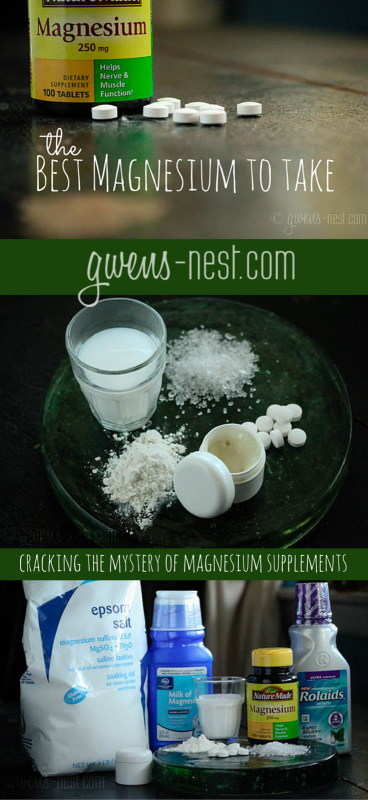
Sources Cited:
1.stability constant for mag oxide and absorption rate: http://www.metabolics.com/blog/the-definitive-guide-to-magnesium-and-magnesium-supplements/
2. milk of magnesia for heartburn https://books.google.com/books?id=tpY3BwAAQBAJ&pg=PA54&dq=absorption+rate+aqueous+MGSO4&hl=en&sa=X&ei=KAk3VaWMK4aMsQSS1oGoAw&ved=0CDkQ6AEwBQ#v=onepage&q=absorption%20rate%20aqueous%20MGSO4&f=false
3.magnesium chloride http://www.traceminerals.com/research/chloride
4. http://www.metabolics.com/blog/the-definitive-guide-to-magnesium-and-magnesium-supplements/
5. http://www.epsomsaltcouncil.org/articles/report_on_absorption_of_magnesium_sulfate.pdf
Can you take a form for constipation and absorption? Also, how do you know if you are magnesium deficient with out doing that sub lingual test?
Thank you!!
Lisa
Hi Lisa,
You *can* take forms for both constipation and deficiency. I’d probably do the absorbent form right before bed, and the constipation supplement after waking. While magnesium is a great choice to address constipation, I’m a bigger fan of addressing the causes behind constipation instead of relying on supplements regularly. Foods with water in them help more than just drinking water, exercise, etc.
My integrative dr told me to take Epsom salts baths to increase my ability to absorb mag. and avoid diarrhea. He also solely recommended, for me , Krebs Magnesium which I get a vitacost. It did wonders for my pain from lyme disease.
The piece of information on mag chloride is definitely one I am going to be thinking on!
For mag sulfate, we have been using this cream:
https://www.pureformulas.com/magnesium-sulfate-cream-4-oz-by-kirkman.html
Forgot to ask. Did your research indicate if magnesium does better if taken on an empty or full stomach?
Very detailed info on magnesium! All these man-made magnesiums just aren’t utilized by our bodies well. There is only one magnesium I will take and that is from MegaFood, made completely from… you guessed it, the only form we can absorb… food.
Hi Tammy,
I do love to get my magnesium from foods as well. 🙂 You’re right that it’s a tricky mineral to absorb. Even from foods, the estimated absorption value is around 40%, which is the same as the magnesium water that I make. It’s just easier for me to take my dose just before bed instead of eating a spinach salad. 🙂 But I probably WOULD eat that spinach salad for lunch or dinner!
Magnesium is often found in nature (mined or extracted from sea water) for many of the forms. Magnesium chloride for example is extracted from an ancient seabed. So they’re not all man made forms, and inorganic forms sometimes are easier for the body to extract and use (like I mention in the post).
Thanks for your tips on another good brand!
I have been taking Mag. malate for fibromyalgia. Is this not good
Hi Ena,
I didn’t study every single form. If you’re noticing positive results, then it may be a great fit for you. 🙂 Malate is malic acid (found in apples among other things), and it can be a useful supplement for energy. What it comes down to is just watching your individual reaction and response to a supplement, and seeing if it’s doing what you want it to do. 🙂
My Neurologist put me on a Magnesium supplement, magnesium L-threonate. This is sold on Amazon as Magtein. It crosses the blood brain barrier and helps with migraines, memory, and many other neurological disorders. I take it for vertigo and migraines. Research is being done to see if it helps with PTSD. It is not confined to the brain, it is just the only one that crosses the blood brain barrier in therapeutic amounts. It is in the general bloodstream too. You might want to do your own research on this.
Thanks, Delaine! Another good form to look into. 🙂
What about Ionic Magnesium? You don’t mention it. Is it good for you?
Hi Marina! I make an ionic magnesium water here: Alkaline Water Recipe. I think it’s a fantastic option for getting consistent low doses of magnesium.
I use the spray for painful ingrown toe nails. Works like a bomb!!!!
Hi my name is Josephine and I have been suffering from rosacea for almost 4 years now. I really do hope you can help me as I am confused to understanding which form of magnesium I should take for my skin condition, I did read on your website that magnesium Chloride is good for low stomach acid and I been reading a lot online about people with rosacea how its actually related to having a low stomach acid, also one lady said to me that I should try to drink epsom salt mixed with a glass of water first thing in the morning and since magnesium hydroxide helps to neutralize stomach acid I thought this would be good to treat rosacea.I know a bit about hydrochloric acid, it helps to alkaline the body …..right ? anyway I just need to know, please tell me what can I do. I would appreciate your support on this.
Hi Josephine,
I’m not sure how much rosacea ties into stomach acid, but I can tell you that you don’t want low stomach acid or to neutralize the acid. If your acid levels are too low, it can be a sign of infection. You’d want to bolster the acidity of your stomach (and ideally address the infection as well, but that would need to be diagnosed to target it.)
The acidity in the stomach is protective for your body, and doesn’t contribute to having an “acid system”. 🙂 If your magnesium level is low, some people do well with oral magnesium, and I like this diy magnesium water recipe. Others do not do well with any type of oral magnesium forms and prefer the lotion or mag oil. I have a recipe for a DIY magnesium oil here. I’d try that first.
Hope that helps! 🙂
I love magnesium oil! I was very itchy initially, but it went away after a while I use it every day, at least 2 times a day. I get pain from a condition called trigeminal neuralgia. Mg oil stopped the severe spasms I was having, whereas oral Mg did not. And I have trouble taking pills anyway so was thrilled with a topical option.
Can I overdose on magnesium? I have been using the magnesium spray once a day. Can I combine both ie.a supplement and spray. Which would be better to help with anxiety, loss of sleep and essential tremor of the head.
You’ll want to speak with your pharmacist or doctor about upper limits and types for supplementing that best suit your needs.
Just wanted to know if magnesium oxide is good for anxiety, depression, fatigue, mood, irritability, my doctor wrote that down as a supplement to take for my anxiety etc. But what I’ve read is it seems to do more for being constipation which I’m not. I need to know I’m getting the right magnesium or if the oxide version will help since its not that absorbable.
Mag oxide is probably not the form I’d use…ask your pharmacist to confirm what type would work for your needs. 🙂
Firstly, Thanks for very clear explanation on magnesium supplements. Loved it ❤️
Experts says, adults who take less amount of magnesium
than recommended amount causes inflammation, in turn which causes
major health conditions.
Preferring natural sources of magnesium – green leafy vegetables, fruits, nuts, seeds, whole grains etc., from your regular diet is the best choice.
Sometimes, If it not possible to include in our regular diet✨
Then, consult your pharmacist and make a choice.
*Magnesium (Glycinate) is a highly bioavailable magnesium chelate,
which supports the metabolism and utilization of carbohydrates.
Hi Gwen,
Thanks for very detailed info on different forms of magnesium
Great work
My problem are painful leg cramps at night
Question is are any magnesium in any form helpfulness?
Try this Magnesium Oil Recipe for leg cramps.